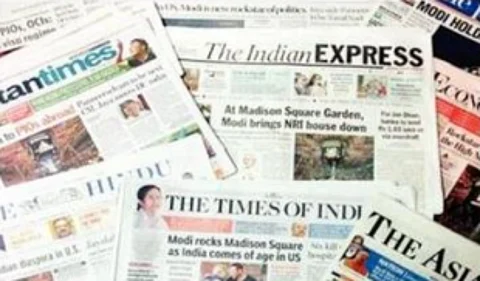

A newspaper earlier this year reported that print media advertising had grown to Rs 16,000 crore in 2021, rising from Rs 12,000 crore in 2020. This year, it would grow to be Rs 18,000 crore, the report said, with newspapers and magazines getting a share of over 20% of the overall advertising market. This was also higher than the global share of 5%, because elsewhere newspapers were dying.
All of this is good news, but what the report did not say was that in 2022, print would get as much advertising as it got in 2019. This trend is also not actually flat but declining at a fast pace. Newspapers and magazines got 53% of all advertising in India as recently as 2005. And seventeen years later, in 2022, digital will get 45% and television 40%. Print and radio and outdoor will have to go after that remains, which is not much.
This is not unique to India of course and it is a worldwide trend.
In the United States, print advertising has halved in just the last five years. It is a much larger market than India’s but even so total advertising to newspapers and magazines fell from $20 billion (approximately Rs 160,000 crore) in 2017 to half of that this year, having fallen each year in the interim. The price of newsprint, and paper on which newspapers are printed, meanwhile has risen.
This is important because it is the single largest component of cost for a newspaper, especially in India where the reader only pays about a fifth of the value of the paper and 80% is paid for by advertisers. If the money from advertising is slowing and even stopping, newspapers become loss making quite quickly.
The question is what is to be done and how. The easiest answer is that if India’s economy shows strong growth over the next few years, newspapers and magazines should be fine for now. That is because people selling consumer products and services will want to send more advertising their way.
If it is the case that growth is weak, then this money will not come to print and the long term decline it has seen will continue.
The numbers show that it is the latter case that has come to be. One indicator is the lack of growth in what is called fast moving consumer goods like soaps and biscuits. This category has seen volume drops especially in rural India. That means a decline in profit for the producers which in turn means a slashing of advertising budgets particularly in media where impact cannot be measured, such as print.
This is actually a matter of great concern. Those who understand how journalism happens know that the largest sets of reporters are all in print. To give you an example, my last job was in a Gujarati newspaper which had 300 reporters. They were spread out across the state and its cities and had regular beats such as corporation, education, crime and so on. This is not how television channels are structured.
They do not require either the number of reporters print has, or the kind of reporting print does. The TV channel’s staple is what is called the debate and here it is the outside experts and guests including political leaders who provide the content.
To know what is happening in your local government school and hospital or the magistrate’s court one has to turn to the newspaper, which is the only source.
It is true that some fine websites have come up that are doing journalism of a sort that was not done before. However they are not structured like newspapers either and do not have the numbers to replicate them particularly of reporters.
If you do a census of journalists in India (or indeed South Asia) the majority will be in print and the majority will be reporters doing basic, essential reporting.
Now consider that along with advertising, even employment in the media has been declining. A report citing data from the Centre for Monitoring the Indian Economy said that the total number of people employed in media and publishing in India was a little over 10 lakh in September 2016. By August 2021, this number had fallen to only 2.3 lakh. This is in line with trends that showed that in the same period jobs in manufacturing had also halved.
The numbers will not be surprising to those working in media who have seen colleagues go and publications shut down. The larger question is what this decline means for our democracy.
Print reporting is the largest source of factual material on the government. It is not replaceable by another medium, even if the other medium were willing. TV and the rise of digital will not and cannot replace print. Newspapers are like a public good, providing a service to society.
What happens to a democracy when the basic information about the performance of the government and the state of institutions declines to the point of vanishing? When citizens do not know what is going on in schools, hospitals, police stations and government offices, how do they hold the state to account?
These are the questions to consider when we examine the rapidity with which print is losing ground, first to TV as it did and now to digital.
(Aakar Patel is a writer and columnist)